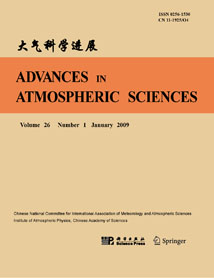| [1] |
Xuehua FAN, Xiang'ao XIA, Hongbin CHEN,
2018: Can MODIS Detect Trends in Aerosol Optical Depth over Land?, ADVANCES IN ATMOSPHERIC SCIENCES, 35, 135-145.
doi: 10.1007/s00376-017-7017-2
|
| [2] |
Xiao ZHANG, Saichun TAN, Guangyu SHI,
2018: Comparison between MODIS-derived Day and Night Cloud Cover and Surface Observations over the North China Plain, ADVANCES IN ATMOSPHERIC SCIENCES, 35, 146-157.
doi: 10.1007/s00376-017-7070-x
|
| [3] |
LI Mingwei, WANG Yuxuan*, and JU Weimin,
2014: Effects of a Remotely Sensed Land Cover Dataset with High Spatial Resolution on the Simulation of Secondary Air Pollutants over China Using the Nested-grid GEOS-Chem Chemical Transport Model, ADVANCES IN ATMOSPHERIC SCIENCES, 31, 179-187.
doi: 10.1007/s00376-013-2290-1
|
| [4] |
YAO Zhigang, Jun LI, ZHAO Zengliang,
2015: Synergistic Use of AIRS and MODIS for Dust Top Height Retrieval over Land, ADVANCES IN ATMOSPHERIC SCIENCES, 32, 470-476.
doi: 10.1007/s00376-014-4046-y
|
| [5] |
ZHONG Lei, MA Yaoming, Zhongbo SU, Mhd. Suhyb SALAMA,
2010: Estimation of Land Surface Temperature over the Tibetan Plateau Using AVHRR and MODIS Data, ADVANCES IN ATMOSPHERIC SCIENCES, 27, 1110-1118.
doi: 10.1007/s00376-009-9133-0
|
| [6] |
Sijie CHEN, Shuaibo WANG, Lin SU, Changzhe DONG, Ju KE, Zhuofan ZHENG, Chonghui CHENG, Bowen TONG, Dong LIU,
2020: Optimization of the OCO-2 Cloud Screening Algorithm and Evaluation against MODIS and TCCON Measurements over Land Surfaces in Europe and Japan, ADVANCES IN ATMOSPHERIC SCIENCES, 37, 387-398.
doi: 10.1007/s00376-020-9160-4
|
| [7] |
Jie ZHANG, Jinyuan Xin, Wenyu ZHANG, Shigong WANG, Lili WANG, Wei XIE, Guojie XIAO, Hela PAN, Lingbin KONG,
2017: Validation of MODIS C6 AOD Products Retrieved by the Dark Target Method in the Beijing-Tianjin-Hebei Urban Agglomeration, China, ADVANCES IN ATMOSPHERIC SCIENCES, 34, 993-1002.
doi: 10.1007/s00376-016-6217-5
|
| [8] |
Yunfei FU, Jiachen ZHU, Yuanjian YANG, Renmin YUAN, Guosheng LIU, Tao XIAN, Peng LIU,
2017: Grid-cell Aerosol Direct Shortwave Radiative Forcing Calculated Using the SBDART Model with MODIS and AERONET Observations: An Application in Winter and Summer in Eastern China, ADVANCES IN ATMOSPHERIC SCIENCES, 34, 952-964.
doi: 10.1007/s00376-017-6226-z
|
| [9] |
Seung-Jae LEE, E. Hugo BERBERY, Domingo ALCARAZ-SEGURA,
2013: The Impact of Ecosystem Functional Type Changes on the La Plata Basin Climate, ADVANCES IN ATMOSPHERIC SCIENCES, 30, 1387-1405.
doi: 10.1007/s00376-012-2149-x
|
| [10] |
Seung-Jae LEE, E. Hugo BERBERY, Domingo ALCARAZ-SEGURA,
2013: Effect of Implementing Ecosystem Functional Type Data in a Mesoscale Climate Model, ADVANCES IN ATMOSPHERIC SCIENCES, 30, 1373-1386.
doi: 10.1007/s00376-012-2143-3
|
| [11] |
WANG Hesong, JIA Gensuo,
2013: Regional Estimates of Evapotranspiration over Northern China Using a Remote-sensing-based Triangle Interpolation Method, ADVANCES IN ATMOSPHERIC SCIENCES, 30, 1479-1490.
doi: 10.1007/s00376-013-2294-x
|
| [12] |
Lian LIU, Massimo MENENTI, Yaoming MA, Weiqiang MA,
2022: Improved Parameterization of Snow Albedo in WRF + Noah: Methodology Based on a Severe Snow Event on the Tibetan Plateau, ADVANCES IN ATMOSPHERIC SCIENCES, 39, 1079-1102.
doi: 10.1007/s00376-022-1232-1
|
| [13] |
Fangfang HUANG, Weiqiang MA, Binbin WANG, Zeyong HU, Yaoming MA, Genhou SUN, Zhipeng XIE, Yun LIN,
2017: Air Temperature Estimation with MODIS Data over the Northern Tibetan Plateau, ADVANCES IN ATMOSPHERIC SCIENCES, 34, 650-662.
doi: 10.1007/s00376-016-6152-5
|
| [14] |
MA Yaoming, WANG Binbin, ZHONG Lei, MA Weiqiang,
2012: The Regional Surface Heating Field over the Heterogeneous Landscape of the Tibetan Plateau Using MODIS and In-Situ Data, ADVANCES IN ATMOSPHERIC SCIENCES, 29, 47-53.
doi: 10.1007/s00376-011-1008-5
|
| [15] |
Xiaoxiong XIONG, William BARNES,
2006: An Overview of MODIS Radiometric Calibration and Characterization, ADVANCES IN ATMOSPHERIC SCIENCES, 23, 69-79.
doi: 10.1007/s00376-006-0008-3
|
| [16] |
WANG Hanjie, SHI Weilai, CHEN Xiaohong,
2006: The Statistical Significance Test of Regional Climate Change Caused by Land Use and Land Cover Variation in West China, ADVANCES IN ATMOSPHERIC SCIENCES, 23, 355-364.
doi: 10.1007/s00376-006-0355-0
|
| [17] |
Mei ZHAO, Andrew J. PITMAN,
2005: The Relative Impact of Regional Scale Land Cover Change and Increasing CO2 over China, ADVANCES IN ATMOSPHERIC SCIENCES, 22, 58-68.
doi: 10.1007/BF02930870
|
| [18] |
ZHENG Jingyun, LIN Shanshan, HE Fanneng,
2009: Recent Progress in Studies on Land Cover Change and Its Regional Climatic Effects over China during Historical Times, ADVANCES IN ATMOSPHERIC SCIENCES, 26, 793-802.
doi: 10.1007/s00376-009-9031-5
|
| [19] |
XIA Kun, WANG Bin, LI Lijuan, SHEN Si, HUANG Wenyu, XU Shiming, DONG Li, LIU Li,
2014: Evaluation of Snow Depth and Snow Cover Fraction Simulated by Two Versions of the Flexible Global Ocean-Atmosphere-Land System Model, ADVANCES IN ATMOSPHERIC SCIENCES, 31, 407-420.
doi: 10.1007/s00376-013-3026-y
|
| [20] |
PENG Lichun, LI Wanbiao,
2014: Parameterizations of Surface Radiation in the Semiarid Grasslands of Inner Mongolia under Clear-Sky Conditions Using MODIS Data, ADVANCES IN ATMOSPHERIC SCIENCES, 31, 1197-1208.
doi: 10.1007/s00376-014-3215-3
|















 AAS Website
AAS Website 
 AAS WeChat
AAS WeChat 
 DownLoad:
DownLoad: